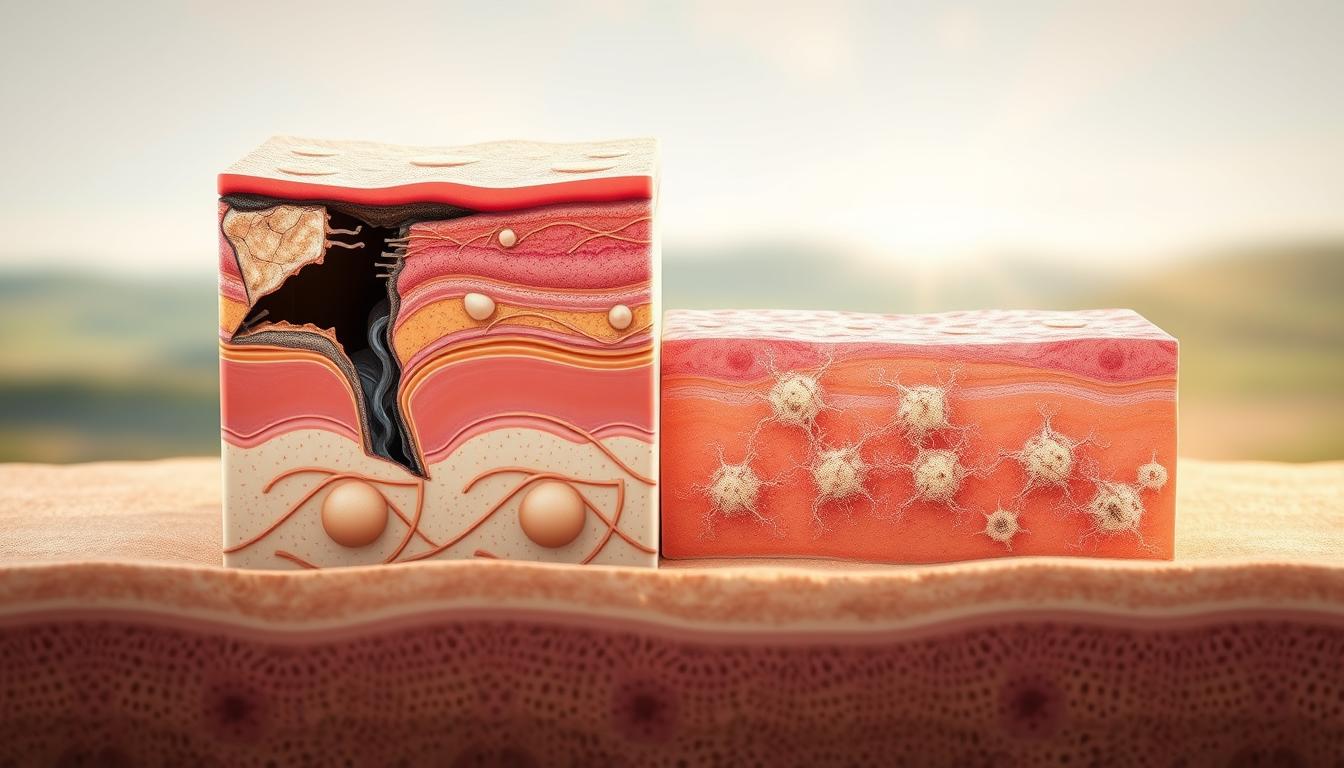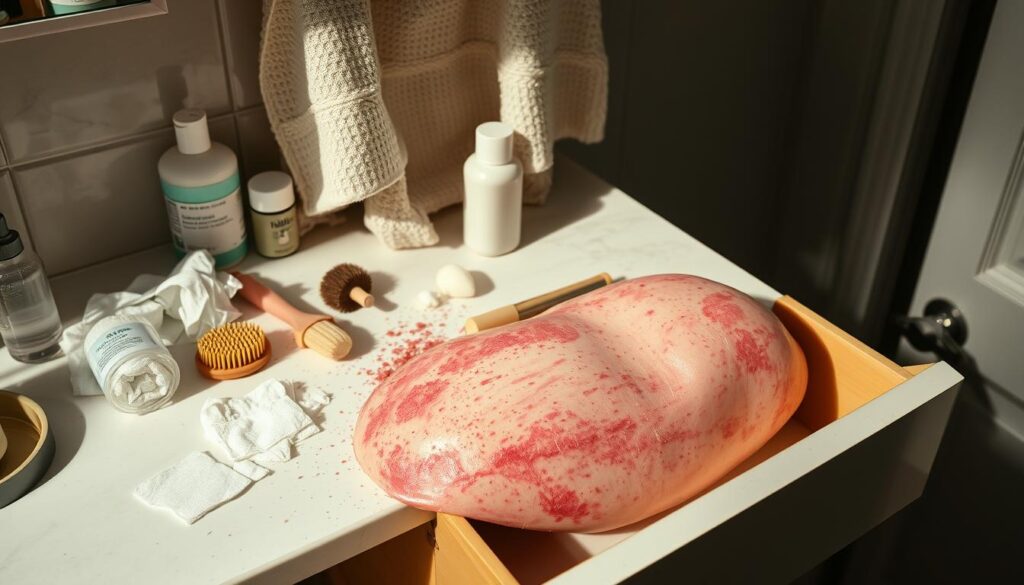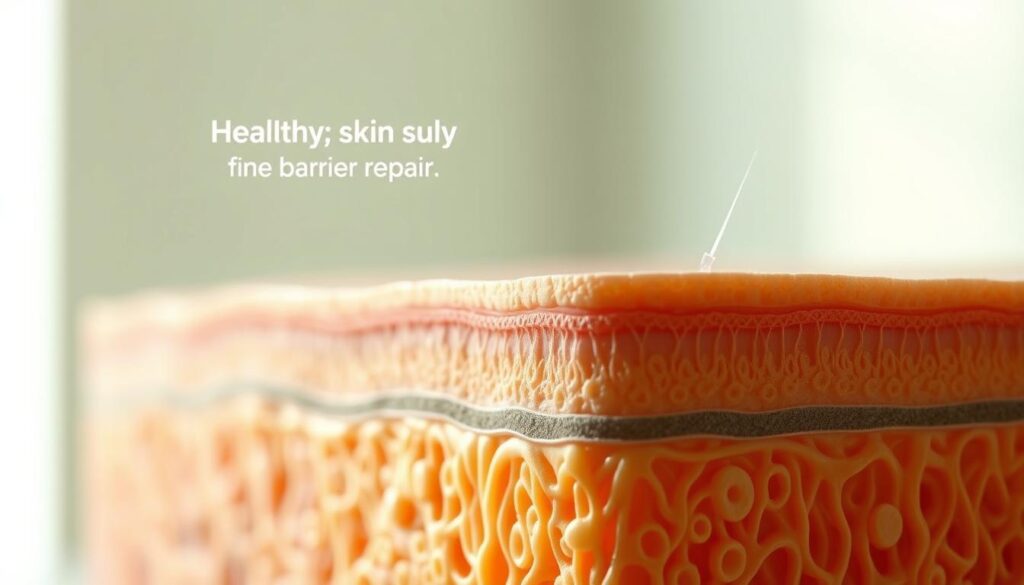At Glowskinhub.com, we believe beauty isn’t just a look—it’s a feeling

Barrier repair after over-exfoliation
Over-exfoliation can lead to irritation, dryness, and increased sensitivity, compromising the Skin’s natural barrier function. When the Skin is over-exfoliated, it loses its ability to protect itself, making it vulnerable to environmental stressors and damage.
Restoring the Skin’s natural balance is crucial to promote healthy Skin and prevent further damage. Effective Skin care routines can help repair and rejuvenate the Skin.
Key Takeaways
- Over-exfoliation can cause irritation and dryness.
- Restoring the Skin’s natural barrier is essential.
- Effective Skin care routines can help repair the Skin.
- Healthy Skin care habits promote Skin rejuvenation.
- Protecting the Skin from environmental stressors is crucial.
Understanding Your Skin’s Protective Barrier
The Skin’s outermost layer, known as the stratum corneum, acts as a protective barrier against external factors. This vital layer is crucial for maintaining Skin health and overall well-being.
What is the Skin barrier?
The Skin barrier, or stratum corneum, is composed of dead Skin cells and lipids. It shields the body from environmental stressors, pathogens, and dryness, playing a critical role in Skin care.

How the barrier functions
The Skin barrier functions by preventing water loss and protecting against external irritants. It achieves this through its unique structure, which is composed of lipids and natural moisturizing factors that help to retain hydration and maintain the integrity of the Skin.
Why a healthy barrier matters
A healthy Skin barrier is essential for preventing irritation, dryness, and other Skin issues. When the barrier is compromised, the Skin becomes more susceptible to damage, emphasizing the importance of maintaining a robust protective barrier for optimal Skin health.
By understanding the role of the Skin’s protective barrier, individuals can take proactive steps to maintain its health and resilience, ultimately supporting their overall Skin care routine.
Signs and Symptoms of Over-Exfoliation
Exfoliating too much can cause immediate and visible damage to your Skin’s barrier. Recognizing the signs of over-exfoliation is crucial for taking corrective action and restoring your Skin’s health.
Visual Indicators of Barrier Damage
One of the first signs of over-exfoliation is redness, which can range from a mild flush to a more intense inflammation. Your Skin may also appear dry, tight, or flaky due to the loss of natural moisture. In some cases, over-exfoliation can lead to visible cracks or fissures, especially around sensitive areas like the mouth or eyes.

Sensory Symptoms You Shouldn’t Ignore
Besides visual cues, over-exfoliation often manifests through uncomfortable sensations. You might experience stinging, burning, or itching, which can be persistent and bothersome. These sensory symptoms are your Skin’s way of signaling that something is amiss.
Differentiating from Other Skin Conditions
It’s essential to differentiate over-exfoliation from other Skin conditions that may present similar symptoms, such as eczema, rosacea, or contact dermatitis. While these conditions share some commonalities with over-exfoliation, their underlying causes differ. Consulting a dermatologist can provide clarity if you’re unsure about the cause of your Skin’s condition.
By understanding the signs and symptoms of over-exfoliation, you can take the first step towards repairing your Skin’s barrier and restoring its natural balance.
Common Causes of Over-Exfoliation
Understanding the causes of over-exfoliation is crucial for maintaining healthy Skin. Over-exfoliation can occur due to various skincare practices, often stemming from a misunderstanding of how to properly care for one’s Skin.
Chemical Exfoliants Gone Wrong
Chemical exfoliants, such as alpha-hydroxy acids (AHAs) and beta-hydroxy acids (BHAs), are powerful tools in skincare. However, using products with too high a concentration or applying them too frequently can lead to exfoliation mistakes. It’s essential to start with lower concentrations and gradually increase as your Skin becomes more tolerant.
Physical Scrubs and Their Impact
Physical scrubs can be harsh on the Skin, especially if used with excessive force or too frequently. The abrasive particles in these scrubs can damage the Skin’s surface, leading to irritation and potentially causing micro-tears. Choosing gentle scrubs and using them sparingly is key to avoiding damage.

Frequency Mistakes to Avoid
Exfoliating too frequently is a common error. The frequency of exfoliation should be tailored to individual Skin types and needs. Over-exfoliating can strip the Skin of its natural oils, leading to dryness and irritation.
Combining Too Many Active Ingredients
Using multiple active ingredients simultaneously can increase the risk of over-exfoliation. When combining products, it’s crucial to be aware of their cumulative effect on the Skin. Layering too many exfoliating products can lead to irritation and compromise the Skin’s barrier function.
Immediate Steps After Over-Exfoliation
The moment you suspect you’ve over-exfoliated, it’s essential to act quickly to soothe and repair your Skin barrier. Over-exfoliation can lead to irritation, dryness, and even infections if not addressed promptly.
First Aid for Compromised Skin
To start the healing process, gently cleanse your face with a mild, non-foaming cleanser that won’t strip your Skin of its remaining natural oils. Look for products labeled ‘gentle’ or ‘for sensitive Skin’. After cleansing, pat dry with a clean towel; avoid rubbing or scrubbing, as this can further irritate the Skin.

Products to Immediately Discontinue
Immediately stop using any exfoliating products, including those containing alpha-hydroxy acids (AHAs), beta-hydroxy acids (BHAs), or physical exfoliants like scrubs or brushes. Also, discontinue any products with active ingredients that might be too harsh for your current Skin condition, such as retinoids or products with high concentrations of vitamin C.
Calming Techniques for Irritated Skin
To calm irritated Skin, apply a soothing mask or a product containing calming ingredients like aloe vera, green tea, or chamomile. Keep the product in the refrigerator for a cooling effect. You can also use a humidifier to add moisture back into the air, helping your Skin retain its natural moisture barrier.
By taking these immediate steps, you can help mitigate the damage from over-exfoliation and set your Skin on the path to recovery. Remember, the key is to be gentle and patient, allowing your Skin the time it needs to heal.
Barrier Repair After Over-Exfoliation: The Recovery Plan
The key to recovering from over-exfoliation lies in a well-structured barrier repair plan. This involves a combination of immediate actions and long-term strategies to restore your Skin’s natural barrier and promote overall Skin health.
Week One Recovery Protocol
During the first week after over-exfoliation, it’s crucial to focus on calming and soothing your Skin. Discontinue all exfoliating products and switch to gentle, non-irritating cleansers and moisturizers. Apply a hydrating Serum or cream to help lock in moisture and support the Skin’s natural repair processes.
- Use lukewarm water instead of hot water to clean your face.
- Avoid harsh products containing alcohol or Fragrance.
- Apply a soothing mask once or twice a week.
Long-term Restoration Strategies
After the initial week, you can start incorporating products that actively support barrier repair. Look for products containing ceramides, hyaluronic acid, and niacinamide, as these ingredients are known to help restore the Skin’s barrier function.
| Ingredient | Benefit |
|---|---|
| Ceramides | Restore the Skin’s barrier function |
| Hyaluronic Acid | Provide intense hydration |
| Niacinamide | Improve Skin elasticity and reduce inflammation |
Monitoring Progress Effectively
To ensure your Skin is recovering properly, monitor its progress closely. Look for signs of improvement such as reduced redness and irritation, and increased hydration levels. Keep a Skin diary to track any changes and adjust your skincare routine accordingly.

By following a structured recovery plan and being patient, you can effectively repair your Skin’s barrier after over-exfoliation and maintain healthy, resilient Skin.
Essential Ingredients for Barrier Repair
When it comes to fixing a damaged Skin barrier, certain ingredients stand out for their ability to replenish and rejuvenate. The Skin’s natural barrier is composed of various elements that work in harmony to protect against external stressors and retain moisture. To effectively repair this barrier, it’s essential to understand the key ingredients that support its restoration.
Ceramides and Their Rebuilding Power
Ceramides are a crucial component of the Skin’s barrier function. They are types of lipids that help restore the Skin’s natural barrier, improving its ability to retain moisture and protect against environmental stressors. Ceramide-based products have been shown to significantly improve barrier function in damaged Skin.
A study published in the Journal of Clinical and Aesthetic Dermatology found that ceramide-containing moisturizers improved Skin hydration and reduced irritation in patients with atopic dermatitis.
Hyaluronic Acid for Hydration
Hyaluronic acid is renowned for its ability to retain moisture, making it an excellent ingredient for hydrating the Skin. It can hold up to 1000 times its weight in water, providing intense hydration that helps to plump and repair the Skin.
“Hyaluronic acid is a powerful humectant that not only attracts moisture but also helps to repair the Skin’s barrier function, making it an essential ingredient in skincare routines aimed at restoring Skin health.”
Niacinamide and Other Healing Actives
Niacinamide is another key ingredient that supports barrier repair. It has been shown to improve the Skin’s barrier function, reduce inflammation, and enhance the Skin’s natural moisture barrier.
Natural Oils and Butters That Help
Natural oils and butters, such as coconut oil, shea butter, and jojoba oil, are rich in nutrients and fatty acids that help nourish and protect the Skin. They can provide an additional layer of hydration and support the Skin’s natural barrier function.
| Ingredient | Benefits | Example Products |
|---|---|---|
| Ceramides | Restore Skin’s barrier function, improve hydration | Ceramide-based moisturizers, serums |
| Hyaluronic Acid | Intensive hydration, plump Skin | Hyaluronic acid serums, moisturizers |
| Niacinamide | Improve barrier function, reduce inflammation | Niacinamide serums, creams |

By incorporating these essential ingredients into your skincare routine, you can effectively support the repair of your Skin’s barrier, leading to healthier, more resilient Skin.
Best Products for Damaged Skin Barrier
Restoring a damaged Skin barrier involves using gentle, effective products that promote healing and hydration. When your Skin is compromised, it’s essential to choose products that won’t further irritate it but instead support its recovery.
Gentle Cleansers for Compromised Skin
For damaged Skin, a gentle cleanser is crucial. Look for cleansers that are Fragrance-free and formulated for sensitive Skin. Ingredients like glycerin and ceramides can help maintain the Skin’s natural barrier while cleansing.
- CeraVe Hydrating Cleanser: This cleanser is Fragrance-free and contains hyaluronic acid and ceramides to help retain moisture.
- Vanicream Gentle Facial Cleanser: Free of fragrances and dyes, this cleanser is gentle on compromised Skin.
Barrier-Repairing Moisturizers
Moisturizers play a key role in repairing the Skin barrier. Look for products containing ceramides, hyaluronic acid, and niacinamide, which help restore and hydrate the Skin.
| Product | Key Ingredients | Benefits |
|---|---|---|
| Cetaphil Moisturizing Cream | Glycerin, Sweet Almond Oil | Provides long-lasting hydration and helps repair dry Skin. |
| La Roche-Posay Toleriane Ultra Fluid | Hyaluronic Acid, Shea Butter | Lightweight hydration for sensitive Skin, promoting comfort and reducing irritation. |
Specialized Treatments and Serums
In addition to cleansers and moisturizers, serums can provide targeted treatment for damaged Skin. Look for serums with ingredients like peptides and antioxidants that help repair and protect the Skin.
“Using a Serum with peptides can significantly improve Skin elasticity and firmness, aiding in the repair of the Skin barrier.” – Dermatology Expert
- Olay Regenerist Micro-Sculpting Serum: Contains vitamin B3 and Amino-Peptide Complex to plump and firm the Skin.
- Drunk Elephant Protini Polypeptide Cream: Combines peptides with antioxidants to improve Skin health and resilience.
By incorporating these products into your skincare routine, you can effectively support the repair of your Skin’s barrier. Remember, patience and consistency are key to seeing improvements.
Lifestyle Factors That Support Barrier Healing
Healing your Skin’s barrier involves more than just topical treatments; it requires a holistic approach that incorporates lifestyle changes. A well-rounded lifestyle can significantly enhance your Skin’s natural ability to repair and maintain its barrier function.
Dietary Influences on Skin Repair
A balanced diet rich in essential nutrients is crucial for Skin health. Foods high in antioxidants, such as berries and leafy greens, help combat oxidative stress, while foods rich in omega-3 fatty acids, like salmon, support Skin hydration and elasticity. Incorporating a variety of whole foods can provide the necessary building blocks for Skin repair.
Stress Management for Healthy Skin
High stress levels can negatively impact Skin health, potentially exacerbating barrier damage. Engaging in stress-reducing activities like yoga, meditation, or deep breathing exercises can help mitigate this effect. By managing stress, you create a more favorable environment for Skin healing.
Sleep and Hydration Importance
Adequate sleep is essential for Skin repair, as it allows the Skin to regenerate and heal. Similarly, staying hydrated by drinking plenty of water helps maintain the Skin’s moisture barrier. Aim for 7-8 hours of sleep per night and drink at least 8 glasses of water a day to support Skin health.

When to Seek Professional Help
Recognizing when your Skin barrier damage requires professional attention is crucial for effective recovery. While many cases of over-exfoliation can be managed with proper self-care, severe or persistent damage may necessitate a visit to a dermatologist.
Signs your barrier damage needs medical attention
If you experience intense, persistent redness, burning, or itching that doesn’t improve with self-care, it’s time to seek professional help. Other signs include visible signs of infection, such as pus or increased sensitivity.
Dermatologist treatments for severe cases
Dermatologists can offer various dermatologist treatments for severe barrier damage, including prescription creams or ointments that may contain corticosteroids or other healing agents. They can also provide guidance on how to gradually reintroduce exfoliating products into your routine.
Professional products worth considering
Some professional products recommended by dermatologists include those containing ceramides, hyaluronic acid, or niacinamide, which are known for their barrier-repairing properties. Examples include products from brands like CeraVe, La Roche-Posay, or SkinCeuticals.
Reintroducing Exfoliation Safely
Reintroducing exfoliation into your skincare routine after over-exfoliation requires patience and a gentle approach. It’s about finding a balance that maintains the health of your Skin while still achieving the benefits of exfoliation.
When it’s Safe to Resume Exfoliating
Wait until your Skin shows no signs of irritation, such as redness, itching, or burning. This could take anywhere from a few days to several weeks, depending on the severity of the over-exfoliation.
Gentle Exfoliation Methods
Start with gentle exfoliants like chemical exfoliants with lower concentrations (around 5-7% for alpha-hydroxy acids) or physical exfoliants with fine particles. Chemical exfoliants like glycolic acid or lactic acid are effective for gentle exfoliation.
Building a Sustainable Routine
Begin with exfoliating once a week and gradually increase frequency based on your Skin’s response. Monitor your Skin closely and adjust your routine as needed.
| Exfoliation Method | Frequency | Skin Type |
|---|---|---|
| Chemical Exfoliant | 1-2 times a week | Sensitive Skin |
| Physical Exfoliant | 1 time a week | Normal to Dry Skin |
Conclusion
Repairing your Skin’s barrier after over-exfoliation requires patience, gentle care, and a well-balanced Skin care routine. By understanding the causes of over-exfoliation and taking immediate action to calm and nourish your Skin, you can restore your Skin’s natural health and resilience.
A healthy Skin barrier is crucial for maintaining overall Skin health, and a consistent Skin care routine can help achieve this. By incorporating essential ingredients like ceramides, hyaluronic acid, and niacinamide into your routine, you can support barrier repair and promote healthy, glowing Skin.
As you move forward, remember to be gentle with your Skin, avoid harsh products, and maintain a balanced lifestyle that supports Skin health. With time and the right care, your Skin can regain its natural balance, leaving you with a radiant and healthy complexion.





